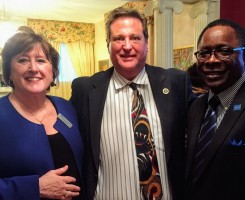Myth and Moral …
The sunbeams shone brightly on the high walls of the old garden. The bees hummed around a bed of purple borage and the fragrance of the blush roses reunited the past and the present. White gardenias, standing side by side, bowed demurely, like nuns honoring the triumphant procession of the sun god who was passing by.
But the tall yellow flowers by the garden wall, were not so shy. In admiration of the golden-haired Apollo, they unabashedly turned their faces to gaze at this sun-god, triumphantly driving his chariot through the heavens.
“Sunflowers” are the big, bold flowers many of us love to see and enjoy standing tall in the summer. We may even plant one or two in the garden to enjoy their towering height and outstanding beauty.
But for many of us, we may not be familiar with the Greek myth of the Sunflower, and the story of a faithful, unrequited love.
Her name was Clytie She was a water- nymph. Shy, timid and gentle, she tended to be drawn to quiet streams, where she enjoyed the company of floating water-lilies and blue dragon flies as they danced on the water’s surface.
At midday, she would take rest in the shade of the tall poplar trees and silvery willows, for fear of the the sun’s harsh glare, causing flowers to droop and the water to lose its coolness.
But one day, Apollo the Conqueror, looked down into the pool by which Clytie sat. Seeing the face of this golden-haired god mirrored in the pool, Clytie was captivated. From that moment on, the picture of the god she had seen in the water, became the master of her heart and soul.
At night, she waited for him, and at the crack of dawn, she was already looking eastward for the first golden gleams from the wheels of his chariot. All day, she followed him with a longing gaze, never ceasing to take her eyes off his beauty until his last radiant reflection had faded from the sky.
While such feelings of warmth might have captured the heart of many, the the sun-god was not so touched and Clytie’s feelings were never reciprocated. Each day her face became more pale, and her lovely form wasted away.
Desiring only one word of love from the sun-god, it was never offered. Scorn and anger was all that was given, finally making it necessary for Clytie to hide in the dense green foliage of shadowy woods.
Enter the goddess, Diana, coming to her defense.
Although somewhat mocking, Diana observes, “In truth the fair nymph who throws her heart’s treasures at the feet of my golden-locked brother that he may trample on them, is coming to look like a faded flower!”
After Diana speaks, the other immortal dwellers were filled with pity, and made a decision among themselves; “A flower she shall be! And for all time shall she live, in life that is renewed each year when the earth stirs with the quickening of spring. The long summer days shall she spend forever in fearless worship of the god of her love!”
And as willed, Clytie changed out of human form, and became the form of a flower, a sunflower; the emblem of constancy. And to this day, does she gaze, with devotion and sincerity, on the face of the sun, her love.
This Greek story of love, reveals the emerging history of Greece, where ideas and images about gods began to shift; from a belief about the nature of gods as transcendent and untouched by human affairs, to a belief about the nature of gods as immanent and participating in human affairs.
Meaning …
Explaining humanity’s existence through the lens of story can be traced back to our very beginning. Observable in all tribes, cultures, societies and civilizations, there seems to be a sense in which story lies close to the center of the mystery of our existence.
Our stories begin in childhood. Hearing the first words spoken to us by our mothers and fathers as newborns, we are all of a sudden introduced to a world outside the previous water-world of the womb. Being received into welcoming arms, we learn we are not alone, that we belong, and we have a place. And the context of our story begins, one that has meaning. It is not a myth.
Stories as the Contexts of our Lives …
For most of us as children, many of the stories we learned began with, “Once upon a time…” This formula is a proven success for beginning fairy tales and stories. And it is also a good way to begin a narrative.
His name is Captain Chesley Sullenberger III. “Sully” for short. An author, speaker and safety advocate, he was also the Captain of the US Airways flight, “Miracle on the Hudson,” Jan. 15, 2009.
Three minutes into the flight, at an approximate altitude of 2,800 feet, the Airbus A320 strikes a flock of birds, disabling both engines. Without engine power and judging themselves unable to reach nearby airports, Teterboro Airport being the closest, Sully ditches the aircraft on the Hudson River. The crew and passengers evacuate without any fatalities.
The press and public hail Sullenburger a hero, but the incident leaves him haunted, and experiencing a dream in which the plane crashes into a building.
In an interview regarding the flight incident, Captain Sullenberger states:
“I have dedicated my entire adult life to aviation safety. I have served as a pilot for more than 40 years, logging more than 20,000 hours of flight experience. In fact, just last month marked the 48th anniversary of my first flying lesson. I have served as an airline check airman (flight instructor) and accident investigator, and continue to serve as an aviation safety expert.
And on January 15, 2009, I was the Captain on US Airways Flight 1549, which has been called the “Miracle on the Hudson.” On that flight, multiple bird strikes caused both engines to fail and, in concert with my crew, including of course our First Officer Jeffrey Skiles, I conducted an emergency landing on the Hudson River saving the lives of all 155 people aboard. And Jeff is with us today in the hearing room. Jeff, I could not have had a better colleague that day or since.
I saw the birds just 100 seconds after takeoff, about two seconds before we hit them. We were traveling at 316 feet per second, and there was not enough time or distance to maneuver a jet airliner away from them. When they struck and damaged both engines, we had just 208 seconds to do something we had never trained for, and get it right the first time.
The fact that we landed a commercial airliner on the Hudson River with no engines and no fatalities was not a miracle, however. It was the result of teamwork, skill, in-depth knowledge, and the kind of judgment that comes only from experience.”
Sully later learned that preliminary data from ACARS suggest that the port engine was still running at idle power. Theoretically, this would have left him with enough power to return to La Guardia or land at Teterboro. Furthermore, the National Transportation Safety Board claims that several confidential computerized simulations show the plane could have landed safely at either airport without engines.
Sully, however, insists that he lost both engines, which left him without sufficient time, speed, or altitude to land safely at any airport. Sully realizes that the Board believes the accident may have been pilot error, which would end his career.
He arranges to have the simulations rerun with live pilots, and the results are relayed to the public hearing. Both simulations result in successful landings, one at each airport.
Sully argues that they are unrealistic because the pilots knew in advance of the situation they would face and of the suggested emergency action, and were able to practice the scenario several times. The board accepts that in real life the pilots would have taken some time to react and run emergency checks before deciding to divert the plane.
Both simulations are rerun and relayed to the hearing, this time allowing a 35-second pause before the plane is diverted. The simulated diversion to LaGuardia ends with the plane landing short of the runway, and to Teterboro with a crash into buildings before the airport.
The board announces that analysis of the port engine, now recovered from the river, confirms Sully’s account that it was disabled by the bird strikes. The board concludes that Sullenberger acted correctly in selecting the best of the options available to him, which in the event saved the 155 passenger and crew lives aboard the plane.
“Sully” Sullenberger is best known for serving as Captain during what has been called the “Miracle on the Hudson”. He is a safety expert, speaker, and author. He still flies privately.
Find more by Captain Sullenberger at: http://www.sullysullenberger.com
The 2016 movie, Sully, produced and directed by Clint Eastwood and associates, tells the story of “Miracle on the Hudson”. It is a five star movie in my opinion!
In honor of Labor Day, I hope you enjoy this post.
Paulette Jackson
credits:
1. Sunflower photo above was taken in Brentwood, Tn. August 2019
2. The myth of Clytie can be found on google
3. The information about meaning can be found in the book, The Night is far Spent, by Thomas Howard.
4. The information regarding “Sully” can be found on Wikipedia.
5. The movie, Sully, starring Tom Hanks, is a 2016 film directed by Clint Eastwood.













